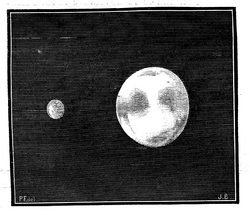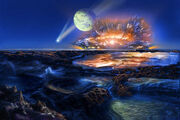
An artist's rendering of planet Venus and its hypothetical moon.
Any elementary school student should be well aware that Venus is the second planet of the Solar System. Covered by thick clouds of sulfuric acid, an average surface temperature greater than planet Mercury, a surface pressure which more resembles those found at the bottom of the oceans of Earth, and a surface covered in volcanoes and lava fields; it's safe to say that Venus is a prime definition of Hell. Given all the exploration which has taken place over the past 50 years, it might be hard to believe that at one point many artists and writers had a very different view of the planet. A living planet covered in oceans, jungles, and exotic creatures. In short, they saw a planet that lived up to Venus' namesake: the goddess of beauty and love, Earth's sister planet.
Despite its bad reputation, it is currently believed that at one point in its history, the planet likely had oceans of water, which simply evaporated due to the planet's closer proximity to the Sun. It has also been theorized that Venus was impacted by larger bodies during its formation (a similar collision on the Earth is believed to have helped form the Moon). With all this chaos affecting the early Solar System, it makes one wonder what would've happened to a planet with the slightest change. What if such a change took place at the rock that would become planet Venus. What if the planet followed a similar path as its sister planet. What would happen to humanity. What would happen if we had a Venusian Haven?
Point of Divergence[]
Approximately 4.5 billion years ago, a protoplanet (roughly the size of Mars) collides into Venus. The angle of impact flips the planet upside down. The leftover material which remains in orbit eventually would coalesce into a moon roughly one-quarter the size of the planet. This new moon forms at a stable orbit, allowing it to gradually move away from Venus over billions of years. The moon's gravity pulls on Venus' rotation, causing it to speed up to be the same as the moon's orbital period (though the two bodies wouldn't remain synchronized as the moon moves further and further).

An artists rendering of the formation of Venus.
Over the next four billion years, Venus gradually begins to cool and water begins to settle across the planet. The moon's tidal pull helps to keep Venus internally active, allowing a magnetic field to remain strong and protecting the surface from the radiation produced by the Sun. As the eons go on, a combination of weather and interplanetary sharing allow amino acids to be produced, which would later form the building blocks for life. Evolution would progress the diversity of life on Venus, which would experience periods of extinction and rebirth.
Today, Venus is a world of oceans and continents, full of exotic lifeforms. There are now two planets in the Solar System which experience the formation of life.
Want to contribute?[]
This timeline is open for anybody who shows interest in joining. Before you consider getting started, it is highly recommended that you get acquainted with the editorial guidelines of the timeline.
| |||||||||||||||||

